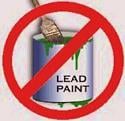RRP Training Refresher: Health Risks of Lead

It’s probably been a while since you took your RRP Certified Renovator Training Class. This blog post is offered as a refresher topic to help you keep important details about the RRP rule top of mind when selling, estimating or performing RRP renovations.
Lead poisoning does not always have obvious symptoms
The symptoms of lead poisoning are often non-specific, and are frequently attributed to other causes. Specific symptoms that people with lead exposure sometimes complain of include:
- Headache
- Stomach ache
- Irritability
- Fatigue
- Loss of appetite
- Joint and/or muscle pain
Because many symptoms are non-specific or similar to flu symptoms, parents may not be alerted to get immediate medical attention for their children. This is critical for young children. The longer a young child stays untreated, the higher the risk of permanent brain damage.

Workers with an occupational exposure to lead need to inform their doctors in order to give them all the background needed for an adequate evaluation of symptoms as possibly related to lead exposure.
The best way to determine if lead is present in the body is by testing blood.
Children under six are most at risk from small amounts of lead.
Children are at a greater risk than adults because their bodies are developing. During normal and frequent playing or hand-to-mouth activity, children may swallow or inhale dust from their hands, toys, food or other objects.
In children, lead can cause:
 Nervous system and kidney damage.
Nervous system and kidney damage.- Decreased intelligence, attention deficit disorder, and learning disabilities.
- Speech, language, and behavior problems.
Among adults, pregnant women are especially at risk from exposure to lead.
Lead is passed from the mother to the fetus and can cause:
 Miscarriages
Miscarriages- Premature births
- Brain damage
- Low birth weight
Are you noticing any of the following about yourself or your co-workers?
Health effects of lead in adults include:
 High blood pressure
High blood pressure- Fertility problems in men and women
 Digestive problems
Digestive problems- Nerve disorders
- Memory and concentration problems
- Sexual disorders
- Muscle or joint pain.
 Posted signs: These must be posted on all sides of the work area to define the work area, must be in the primary language of occupants, must be posted before the beginning of the renovation, and must remain until cleaning verification is achieved.
Posted signs: These must be posted on all sides of the work area to define the work area, must be in the primary language of occupants, must be posted before the beginning of the renovation, and must remain until cleaning verification is achieved. Remove or cover furniture/objects: Remove (preferred) objects like furniture, rugs, window coverings; or cover them with plastic sheeting with all seams and edges taped.
Remove or cover furniture/objects: Remove (preferred) objects like furniture, rugs, window coverings; or cover them with plastic sheeting with all seams and edges taped. Cover duct opening: Close and cover all HVAC vents in the work area with taped down plastic sheeting or other impermeable materials (e.g., magnetic covers).
Cover duct opening: Close and cover all HVAC vents in the work area with taped down plastic sheeting or other impermeable materials (e.g., magnetic covers).
 Looking for accurate information about the EPA RRP rule?
Looking for accurate information about the EPA RRP rule? 

 Containment is required by the RRP Rule because it reduces the risk to you and residents. Following the work area setup requirements will protect you, your co-workers and residents by confining lead-contained dust and debris to a defined and demarcated area. Confining the lead is an important consideration in avoiding exposure. Reducing the risk to you and co-workers is also dependent upon use of personal protective equipment. Requirements for the personal protection of workers are established by OSHA and can be found in the OSHA document titled
Containment is required by the RRP Rule because it reduces the risk to you and residents. Following the work area setup requirements will protect you, your co-workers and residents by confining lead-contained dust and debris to a defined and demarcated area. Confining the lead is an important consideration in avoiding exposure. Reducing the risk to you and co-workers is also dependent upon use of personal protective equipment. Requirements for the personal protection of workers are established by OSHA and can be found in the OSHA document titled  Proper containment also facilitates efficient cleaning of the work area. The pre-work setup process is essential to keeping lead-contaminated dust confined to the work area where it can be easily cleaned. Proper containment of the work area helps to limit the area you need to clean after the job is complete. Knowing exactly where to clean is an important factor in saving time (and money) spent on cleanup.
Proper containment also facilitates efficient cleaning of the work area. The pre-work setup process is essential to keeping lead-contaminated dust confined to the work area where it can be easily cleaned. Proper containment of the work area helps to limit the area you need to clean after the job is complete. Knowing exactly where to clean is an important factor in saving time (and money) spent on cleanup.  Covering floors (or the ground) with plastic sheeting a minimum distance beyond the surfaces being renovated (6 feet for interior jobs and 10 feet for exterior jobs).
Covering floors (or the ground) with plastic sheeting a minimum distance beyond the surfaces being renovated (6 feet for interior jobs and 10 feet for exterior jobs). Workers with an occupational exposure to lead need to inform their doctors in order to give them all the background needed for an adequate evaluation of symptoms as possibly related to lead exposure.
Workers with an occupational exposure to lead need to inform their doctors in order to give them all the background needed for an adequate evaluation of symptoms as possibly related to lead exposure. Nervous system and kidney damage.
Nervous system and kidney damage. Miscarriages
Miscarriages High blood pressure
High blood pressure Digestive problems
Digestive problems
 as described within a scope of work for the project, test lead free by a Certified Risk Assessor, Lead Inspector or Certified Renovator
as described within a scope of work for the project, test lead free by a Certified Risk Assessor, Lead Inspector or Certified Renovator


